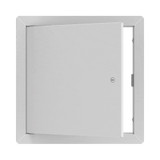How Do Access Doors Help Comply with Canadian Building Codes and Regulations?
Access doors are designed to meet Canadian fire safety, insulation, and accessibility standards, ensuring compliance with national and provincial codes. Building codes in Canada aren't just rules; they're your project's safety net. They ensure that your construction or renovation is up to code, creating a reliable and safe space.
Beyond the blueprints and legalities, have you ever considered how something as straightforward as an access door can make or break your project’s compliance?
Access doors are not just functional panels that blend into the walls—they’re integral to meeting some of Canada's most stringent building standards. From fire safety to insulation and accessibility, these doors are the unsung heroes that help ensure your building meets the code and exceeds expectations.
Fire Safety: Protecting Lives and Investments
Let’s start with fire safety, one of the most critical aspects of any building project. Canadian building codes are rigorous regarding preventing and managing fire risks, and rightly so. A fire can devastate property and, more importantly, put lives at risk.
According to the Fire Safety Research (NRC), fire-resistant materials can significantly impact building safety by maintaining structural integrity and providing critical time for evacuation.
A quality-designed fire-rated access door can offer up to 90 minutes or more of protection by delaying the spread of flames and smoke, which is vital for safe evacuation and effective fire control. By choosing high-quality, fire-rated access doors, you're complying with regulations and safeguarding lives and investments.
Energy Efficiency: Insulating for a Greener Future
As Canada pushes towards more sustainable building practices, energy efficiency has become a cornerstone of modern construction. Buildings today aren’t just built to stand the test of time—they’re built to minimize environmental impact, and that’s where a high-performing, eco-conscious insulated access door comes into the picture.
According to Natural Resources Canada, upgrading building insulation, including insulated access doors, can cut energy use by up to 30%. Since buildings contribute nearly 17% of Canada’s total greenhouse gas emissions, improving insulation is a crucial step toward lessening the environmental footprint of construction projects.
Choosing the right insulated access door that meets Canadian energy efficiency standards is crucial as the country works to reduce its carbon footprint. These doors help maintain a building's internal temperature, reducing the need for excessive heating or cooling. This saves energy and translates to lower utility bills for building owners.
Weather-Resistant Access
Weather conditions in Canada can be extreme, making it essential to select products that can withstand these environmental stresses. Complying with building codes ensures your structure remains safe, durable, and energy-efficient in challenging weather. Building codes in Canada are designed to guarantee that structures can handle various weather conditions, from intense cold to heavy rain and high winds.
When it comes to external access panels, the ADC-EXT Exterior Access Panel—a weather-resistant door designed to withstand even the harshest Canadian weather—stands out. Engineered for superior performance, this panel features a 20-gauge (1mm) plate or aluminum construction, providing exceptional strength and rigidity. Its continuous stainless steel piano hinge and key-operated turn latch closure offer both durability and security, while its welded aluminum frame and inner aluminum inlay enhances its structural integrity.
Accessibility: Designing for Everyone
In today’s world, inclusivity isn’t just a trend—it’s a necessity. Canadian building codes mandate that buildings be accessible to everyone, regardless of physical ability. Access doors can help you meet those essential accessibility standards.
Access doors aren’t just for maintenance crews; they’re for anyone who needs to move through a building, including people with disabilities. By installing access doors that comply with accessibility standards, you’re ensuring that your building is safe and inclusive for everyone.
This isn’t just about ticking a regulatory box—it's about creating welcoming and functional spaces for all.
Real-World Impact: How Access Doors Shape Success
Let’s bring this closer to home with a real-world example. Imagine you’re a building owner managing a large commercial property in Toronto. You’ve worked with a team of architects and builders to ensure the building is up to code, but you’re also concerned about long-term maintenance and energy costs.
By selecting the right fire-rated and insulated access doors, you’ve proactively complied with local regulations, protected your investment, and contributed to a sustainable future. And it’s not just about compliance—these decisions have real financial benefits. The energy savings from insulated doors help reduce operating costs, and the enhanced fire safety features can lower insurance premiums.
Final Takeaways
At the end of the day, access doors are more than just functional elements—they’re key components that help you meet Canadian building codes and regulations. So, the next time you plan a construction or renovation project, think beyond the basics, and choose solutions that set your work apart.
Ready to take your commercial project to the next level? Start by investing in the right access doors, like our fire-rated access door or insulated access door options. Explore our website or contact us today to learn how the right access door can benefit your next design. Your project deserves the best; your project deserves Access Doors Canada.









